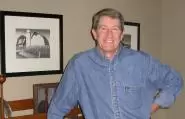Letting Your Curiosity Lead You Astray

Curiosity is a wonderful thing.
And wonderful things happen when people get curious.
Take Laura Hope-Gill, for instance.
A poet and writer, she has been researching material for her latest book, Look Up Asheville, a guide to Asheville’s architectural heritage. While doing so, she stumbled across one line in an essay that caught her attention. In the essay it was mentioned that Mary Tillinghast may have designed the stained glass windows for the Trinity Episcopal Church in 1912, the same year she died.
Mary Tillinghast?
Not exactly a household word, even among Arts & Crafts enthusiasts, but Mary Tillinghast studied under Louis Comfort Tiffany, then was lured away from Tiffany by his rival John La Farge. Tillinghast rose to become La Farge’s partner before splitting off to form her own company specializing in stained glass windows, interior design and custom textiles. She even designed furniture.
It was enough to send Laura Hope-Gill off on one of those delectable tangents that researchers love – but that can wreck havoc on deadlines. It’s a sticky web….
Mary Tillinghast was born in 1845, studied art in Rome and Paris until the family fortune was wiped out, then worked as a nanny in Boston before hooking up with Tiffany. Her many talents were recognized during her lifetime, as she was among the first women to be inducted into the American Institute of Architects, secured a $30,000 textile commission from one of the New York Vanderbilts, designed stained glass windows for churches as far away as Pittsburg and Asheville, and was awarded medals at World Fairs.
Yet there is scarcely a mention of her in any historical documents.
A few letters, some newspaper articles, but that’s about it.
No personal papers, no drawings, no notebooks.
Laura Hope-Gill has teamed up with Kent Watkins, a distant relative of Mary Tillinghast who has also been researching the talented, but nearly forgotten artist, to share their discoveries. Watkins noted that while Tillinghast stood only five feet tall, “she seemed to be aware of how to stand out. She was strong-willed, feisty and notorious for her social gatherings with other artists in her Washington Square apartment.”
(Translation: Mary knew how to party.)
In a recent interview, Laura Hope-Gill hopes that her experience will “inspire more people to ask more questions about who did what — and I think that a lot of those people will find out those artists were women.”
Curiosity – it’s a wonderful thing.
For more photos of the windows at Trinity Episcopal Church, go to http://www.Citizen-Times.com.

Until next Monday,
Bruce Johnson
